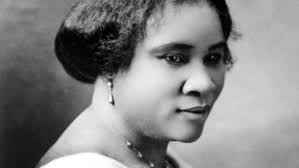
Madam C. J. Walker
She is said to be the first self-made female millionaire in the US and she was black. How could a black woman set up and run a big enterprise in America in the early years of the 20th century? That was the achievement of Madam C. J. Walker.
She was born on December 23, 1867 as Sarah Breedlove to freed slaves on a plantation in Delta, Louisiana. She became an orphan at the age of seven, got married at 14, and had one daughter, A’Lelia. Six years later, Sarah’s husband died, probably in a race riot. Sarah then made a living as a washerwoman. She was, however, always dreaming of a better future for herself and her daughter. She later told The New York Times, “As I bent over the washboard and looked at my arms buried in soapsuds, I said to myself: ‘What are you going to do when you grow old and your back gets stiff? Who is going to take care of your little girl?’”
When the new century arrived, Sarah moved to St. Louis and worked for an African-American hair care company. She began thinking of starting such a business herself. She moved to Denver where the dry air was supposed to exacerbate hair and scalp issues. African-American women were in particular vulnerable to such issues. She herself lost a lot of her hair.
She was again working a washerwoman, when she dreamt of a formula for a hair tonic. She made the tonic and used it on herself with very good results. She named her concoction as ‘Wonderful Hair Grower’ and began selling it door-to-door and at church events. She travelled throughout the South and Northeast, selling her product and recruiting other saleswomen.
In 1906, she married Charles Joseph Walker and set up the Madam C. J. Walker Manufacturing Company. From then on, she was known by that name. Again, in 1908, she founded Lelia College in Pittsburgh, a beauty parlor and school for training Madam Walker brand ambassadors. Two years later, she relocated her business headquarters to Indianapolis, where she and a mostly female cadre of top executives produced Wonderful Hair Grower on an industrial scale. Business was doing very well.
Later, at the instance of her daughter, Walker moved to New York. She joined the New York chapter of the National Association for the Advancement of Colored People (NAACP) and helped in the organization of the Silent Protest Parade in 1917. More than 10,000 African-Americans marched down Fifth Avenue as a demonstration against the East St. Louis race riots earlier that year, in which many African-Americans had been killed.
According to A’Lelia Bundles, Walker’s biographer and great-great-granddaughter, “She became politically active and very much an advocate of women’s economic independence. She used her national platform to advocate for civil rights.”
Later in 1917, Walker and a group of Harlem leaders traveled to the White House to petition for anti-lynching legislation. She donated $5000 to the NAACP’s Anti-Lynching Fund and also established the Madam C. J. Walker Benevolent Association, a program that encouraged Walker brand ambassadors to engage in charity work and hygiene education outreach.
Business was booming, but Walker’s health was failing, as she drove herself hard to introduce new products and develop the company. Tragically, she died of kidney failure in 1919, at the age of 51.
Apart from becoming the first woman millionaire in the US, she laid the foundation for black entrepreneurship in the country.
Afterword: Several biographies of Walker are available. There is a four-part video serial on Netflix, with Octavia Butler playing the role of Walker.
For this story, I have drawn heavily from an article in Mental Floss.
